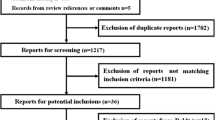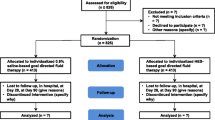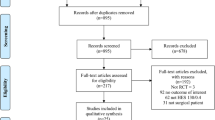Abstract
Purpose
The intravenous fluid 6% hydroxyethyl starch (130/0.4) (6% HES 130/0.4) is used widely for resuscitation but there is limited information on its efficacy and safety. A large-scale multi-centre randomised controlled trial (CHEST) in critically ill patients is currently underway comparing fluid resuscitation with 6% HES 130/0.4 to 0.9% sodium chloride on 90-day mortality and other clinically relevant outcomes including renal injury. This report describes the study protocol.
Methods
CHEST will recruit 7,000 patients to concealed, random, parallel assignment of either 6% HES 130/0.4 or 0.9% sodium chloride for all fluid resuscitation needs whilst in the intensive care unit (ICU). The primary outcome will be all-cause mortality at 90 days post-randomisation. Secondary outcomes will include incident renal injury, other organ failures, ICU and hospital mortality, length of ICU stay, quality of life at 6 months, health economic analyses and in patients with traumatic brain injury, functional outcome. Subgroup analyses will be conducted in four predefined subgroups. All analyses will be conducted on an intention-to-treat basis.
Results and conclusions
The study run-in phase has been completed and the main trial commenced in April 2010. CHEST should generate results that will inform and influence prescribing of this commonly used resuscitation fluid.

Similar content being viewed by others
References
Miletin M, Stewart T, Norton P (2002) Influences on physicians’ choices of intravenous colloids. Intensive Care Med 28:917–924
American Thoracic Society (2004) Evidence-based colloid use in the critically ill: American Thoracic Society Consensus Statement. Am J Respir Crit Care Med 170:1247–1259
Perel P, Roberts I, Pearson M (2007) Colloids versus crystalloids for fluid resuscitation in critically ill patients. Cochrane Database Syst Rev. doi:10.1002/14651858.CD14000567.pub14651853
Bunn F, Trivedi D, Ashraf S (2008) Colloid solutions for fluid resuscitation. Cochrane Database Syst Rev CD001319
The SAFE Study Investigators (2004) A comparison of albumin and saline for fluid resuscitation in the intensive care unit. N Eng J Med 350:2247–2256
The SAFE Study Investigators (2007) Saline or albumin for fluid resuscitation in patients with traumatic brain injury. N Engl J Med 357:874–884
Brunkhorst FM, Engel C, Bloos F, Meier-Hellmann A, Ragaller M, Weiler N, Moerer O, Gruendling M, Oppert M, Grond S, Olthoff D, Jaschinski U, John S, Rossaint R, Welte T, Schaefer M, Kern P, Kuhnt E, Kiehntopf M, Hartog C, Natanson C, Loeffler M, Reinhart K, German Competence Network (2008) Intensive insulin therapy and pentastarch resuscitation in severe sepsis. N Engl J Med 358:125–139
Dart A, Mutter T, Ruth C, Tabak S (2010) Hydroxyethyl starch (HES) versus other fluid therapies: effects on kidney function. Cochrane Database Syst Rev. doi:10.1002/14651858.CD14007594.pub14651852.
The FLUIDS Study Investigators for the Scandanavian Critical Care Trials Group (2008) Preferences for colloid use in Scandinavian intensive care units. Acta Anaestheiol Scand 52(6):750–758
Schortgen F, Deye N, Brochard L, CS Group (2004) Preferred plasma volume expanders for critically ill patients: results of an international survey. Intensive Care Med 30:2222–2229
Jones D, McEvoy S, Merz T, Higgins A, Bellomo R, Cooper J, Hollis S, McArthur C, Myburgh J, Taylor C, Liu B, Norton R, Finfer S (2010) International albumin use: 1995–2006. Anaesth Intensive Care Med 38:266–273
Zarychanski R, Turgeon A, Fergusson D, Cook D, Hebert P, Bagshaw S, Monsour D, McIntyre L (2008) Renal outcomes following hydroxyethyl starch resuscitation: a meta-analysis of randomized trials. Clin Invest Med 31:S26
Boldt J, Brenner T, Lehmann A, Lang J, Kumle B, Werling C (2003) Influence of two different volume replacement regimens on renal function in elderly patients undergoing cardiac surgery: comparison of a new starch preparation with gelatin. Intensive Care Med 29:763–769
Boldt J, Brosch C, Ducke M, Papsdorf M, Lehmann A (2007) Influence of volume therapy with a modern hydroxyethylstarch preparation on kidney function in cardiac surgery patients with compromised renal function: a comparison with human albumin. Crit Care Med 35:2740–2746
Boldt J, Brosch C, Rohm K, Papsdorf M, Mengistu A (2008) Comparison of the effects of gelatin and a modern hydroxyethyl starch solution on renal function and inflammatory response in elderly cardiac surgery patients. Br J Anaesth 100:457–464
Fenger-Eriksen C, Hartig Rasmussen C, Kappel Jensen T, Anker-Moller E, Heslop J, Frokiaer J, Tonnesen E (2005) Renal effects of hypotensive anaesthesia in combination with acute normovolaemic haemodilution with hydroxyethyl starch 130/0.4 or isotonic saline. Acta Anaesthesiol Scand 49:969–974
Mahmood A, Gosling P, Vohra RK (2007) Randomized clinical trial comparing the effects on renal function of hydroxyethyl starch or gelatine during aortic aneurysm surgery. Br J Surg 94:427–433
Neff TA, Doelberg M, Jungheinrich C, Sauerland A, Spahn DR, Stocker R (2003) Repetitive large-dose infusion of the novel hydroxyethyl starch 130/0.4 in patients with severe head injury. Anesth Analg 96:1453–1459
Antonelli M, Azoulay E, Bonten M, Chastre J, Citerio G, Conti G, De Backer D, Lemaire F, Gerlach H, Hendenstierna G, Joannidis M, Macrae D, Mancebo J, Maggiore S, Mebazaa A, Preiser J-C, Pugin J, Wernerman J, Zhang H (2010) Year in review in Intensive Care Medicine 2009: II. Neurology, cardiovascular, experimental, pharmacology and sedation, communication and teaching. Intensive Care Med 36:412–427
Kellum J, Bellomo R, Ronco C (2007) The concept of acute kidney injury and the RIFLE criteria. Contrib Nephrol 156:10–16
Vincent JL, de Mendonca A, Cantraine F, Moreno R, Takala J, Suter PM, Sprung CL, Colardyn F, Blecher S (1998) Use of the SOFA score to assess the incidence of organ dysfunction/failure in intensive care units: results of a multicenter, prospective study. Crit Care Med 26:1793–1800
EuroQoL Group (1990) EuroQoL—a new facility for the measurement of health-related quality of life. Health Policy 16:199–208
Teasdale G, Pettigrew L, Wilson J, Murray G, Jennett B (1998) Analyzing outcome of treatment of severe head injury: a review and update on advancing the use of the Glasgow Outcome Scale. J Neurotrauma 15:587–597
US Food and Drug Administration (2003) Guidance for industry. Part 11. Electronic signatures—scope and applications. Available at:http://www.21cfrpart11.com/files/fda_docs/part11_final_guidanceSep2003.pdf
Knaus W, Draper E, Wagner D, Zimmerman J (1985) APACHE II: a severity of disease classification system. Crit Care Med 13:818–829
The NICE-SUGAR Study Investigators (2009) Intensive versus conventional glucose control in critically ill patients. N Engl J Med 360:1283–1297
Uchino S, Kellum J, Bellomo R, Doig G, Morimatsu H, Morgera S, Schetz M, Tan I, Bouman C, Macedo E, Gibney N, Tolwani A, Ronco C (2005) Acute renal failure in critically ill patients. JAMA 294:813–818
Author information
Authors and Affiliations
Consortia
Additional information
Members of the Crystalloid versus Hydroxyethyl Starch Trial (CHEST) Management Committee are listed in the Appendix.
Electronic supplementary material
Below is the link to the electronic supplementary material.
Appendix: Crystalloid versus Hydroxyethyl Starch Trial (CHEST) Management Committee
Appendix: Crystalloid versus Hydroxyethyl Starch Trial (CHEST) Management Committee
John Myburgh (Chair, George Institute, University of New South Wales, St George Hospital, Sydney), Rinaldo Bellomo (George Institute, University of Melbourne, Austin Hospital, Melbourne), Alan Cass (George Institute, University of Sydney), Simon Finfer (George Institute, University of Sydney, Royal North Shore Hospital, Sydney), Julie French (Project Manager, George Institute), David Gattas (Royal Prince Alfred Hospital, Sydney), Parisa Glass (George Institute), Joanne Lee (George Institute), Jeffrey Lipman (University Queensland, Royal Brisbane and Women’s Hospital) , Bette Liu (George Institute, University of Sydney) , Colin McArthur (Australian and New Zealand Intensive Care Society Clinical Trials Group), Shay McGuinness (Auckland Cardiovascular Hospital, New Zealand), Dorrilyn Rajbhandari (George Institute), Colman Taylor (George Institute, University of Sydney), Steve Webb (Australian and New Zealand Intensive Care Society Clinical Trials Group).
Rights and permissions
About this article
Cite this article
The Crystalloid versus Hydroxyethyl Starch Trial (CHEST) Management Committee. The Crystalloid versus Hydroxyethyl Starch Trial: protocol for a multi-centre randomised controlled trial of fluid resuscitation with 6% hydroxyethyl starch (130/0.4) compared to 0.9% sodium chloride (saline) in intensive care patients on mortality. Intensive Care Med 37, 816–823 (2011). https://doi.org/10.1007/s00134-010-2117-9
Received:
Accepted:
Published:
Issue Date:
DOI: https://doi.org/10.1007/s00134-010-2117-9




